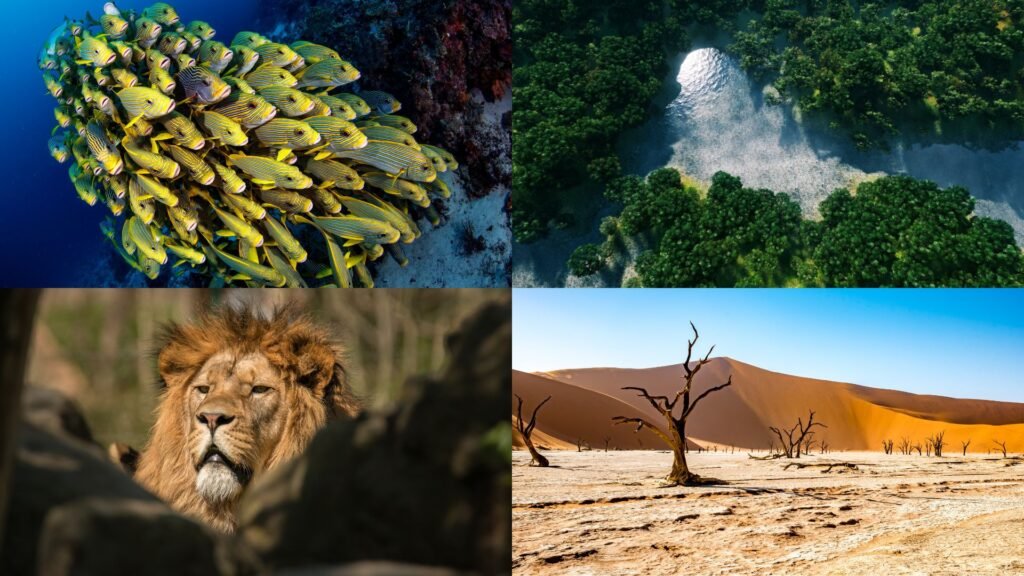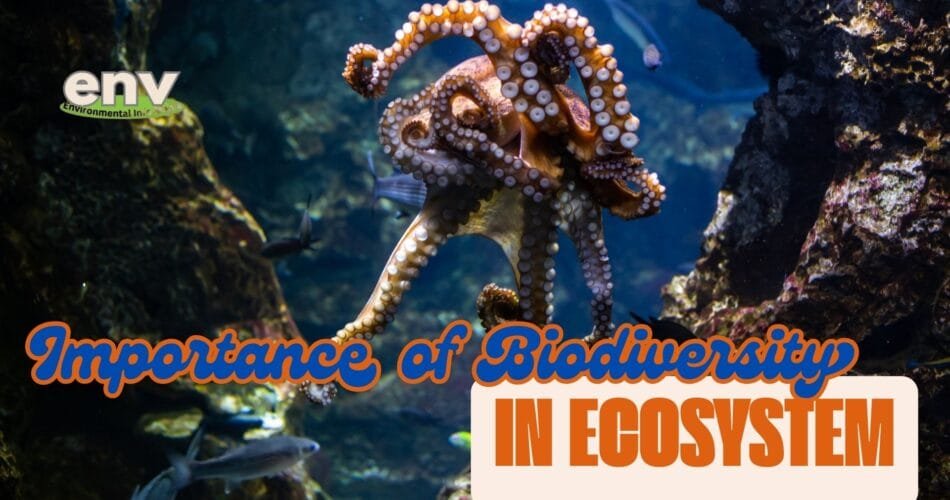This blog contains Ecosystem, Types and Importance of Biodiversity in Ecosystem. It contains the contributions of Biodiversity in maintaining the Ecosystem. These contribution includes Stabilizing the Ecosystem, Building Resilience, Production of Oxygen, Clean Air and Water, Pest Control etc. This blog shows the Importance of Biodiversity in Ecosystem.
1. What is the Definition of Ecosystem?
An Ecosystem is a complex system consisting of living organisms and their Physical Environment, that are interacting as a unit within a specific Geographical Area.
Every living system on Earth is called as Ecosystem. Because it makes a combination of Living and Non-living materials interacting with each other to make a system. The living and non-living part of the environment is necessary to complete the processes and activities going on. Even the disruption and also disturbance in the functioning of a single component of the Ecosystem, can make the whole system destroyed and destructed. This is directly the loss of Nature. The Earth’s Geological systems works because of the presence of Ecosystems on Earth.
Ecosystem carries Living and non-living parts of the Environment at the same time and with the same importance. Because each component have same value in order to maintain balance into the environment. We will have a Complete description about Types and the Importance of Biodiversity in an Ecosystem in this blog.
2. What are Main Components of an Ecosystem?
There are two categories of the Components of an Ecosystem. They interact with each other and play their role in maintaining and processing of it. Both of these Components are equally important in all the processes but living varieties takes the spotlight because of some life processes driven by Biodiversity. And it is considered much important than Abiotic Component of the Environment. Disturbance in any of the component, may cause disturbance in the whole Ecosystem. Following are the Components of an Ecosystem:
i. Biotic Components:
Biotic components refers to all the living organisms or Biodiversity present in an Ecosystem. This includes all the processes and activities that are carried out with the help of living things in an Ecosystem to be working. The Biotic Components are characterized into Three Types based on their Nutrition. These are explained as follows:
Producers:
Producers are the autotrophs that are not dependent on other organisms for food and nutrition. They make their own food and are also source of food for other Biodiversity. These are the efficient organisms that are independent of all other organisms in a living system. For Example, Plants are the producers in an Ecosystem.
Consumers:
All the heterotroph organisms are included in Consumers. These organisms depends on other living organisms and Biodiversity for their food. They cannot make their own food. Consumers consumes by predation, flesh eating and other ways of getting food from other organisms. For Example, Humans and Animals depend on other living species for their food.
Decomposers:
These organisms are also called as Saprophytes. Decomposers are the ones that degrades the dead organic matter by through their natural ability of Decomposition or Biodegradability. Their role is to recycle the nutrients after the death of Living organisms and they also return the Environmental nutrients back to the Environment. For Example, Bacteria and Fungi are Decomposers in an Ecosystem.
These three major groups of Biodiversity are present in an Ecosystem to maintain check and balance in the Environment. And also stabilizes the ecosystem to prevent it from getting destroyed.
ii. Abiotic Components:
Abiotic Components are opposite genre from Biotic Components. These are the Non-living part of the Eco-system. They also have roles in maintaining Ecosystem and Ecosystem Activities with the interaction of Biotic Components. The Abiotic Components includes minerals, soil, temperature, nutrients, wind, altitude, turbidity, air etc.
These are the main components of an Ecosystem to work as a complete and stabilized system. All the ecosystem activities goes on with the help of both of its biotic and abiotic components. This blog contains Types and Importance of Biodiversity in Ecosystem.

3. What is the Importance of Biodiversity in Ecosystem?
Biodiversity includes the variety of life present on Earth. While Ecosystem is a complex system in which living and non-living components of the Environment interact with each other as a unit. Living varieties are very crucial for Ecosystem as it maintains it in many ways. Some of the Contributions of Biodiversity in the Ecosystem are as follow:
- Ecosystem Resilience
- Productivity of Ecosystem
- Stability of Ecosystem
- Ability to Adapt etc.
i. Ecosystem Resilience:
Biodiversity helps in maintaining resilience in ecosystem. As the resilience is the ability of a thing to fight in the time of danger and stability is maintaining balance in the system. If the resilience of an Ecosystem would be weak, it will destroy in extreme Climatic Condition and its foundation will be weak to survive on Earth. That is why Biodiversity helps a lot in maintaining Ecosystem Resilience in an Ecosystem.
ii. Productivity of Ecosystem:
Biodiversity is the living part of Ecosystem. It participates in food production, transfer of nutrients and carrying out all the essential processes. So we can say that living things is responsible for the productivity of an Ecosystem. As it contributes in making and transferring the nutrients and also their complete cycle in order make a Productive living system in nature. This can’t be done by Abiotic Component of the Ecosystem. So, biodiversity ensures the food security in an ecosystem.
iii. Ecosystem Stability:
Biodiversity also contributes in maintaining Stability in an Ecosystem. It can be in the form of Ecological balance, nutrient balance, and many such other things needed for the stability of a living system. Stability is very important as it saves the ecosystem from imbalance and also getting destroyed. Biodiversity, by performing different life processes makes the ecosystem stable in every way and increase its life-time.
iv. Ability to Adapt:
Biodiversity always work for their adaptation and they have a large capacity to adapt according to the changing environment such as Climate Change and Geological Changes. Their adaptation also help the whole Ecosystem to adapt as the Environmental Changes occurs in the Ecosystem. Biodiversity helps the Ecosystem to adapt to be stronger in the Environment. This factor contributes in building the adaptation ability of the Ecosystem as a whole.
v. Ecological Balance:
When species interact with each, they form complex food web interactions. For example, the predators reduce the population of the prey, while herbivores manage plant growth. Decomposers are specialized for the recycling of the nutrients. Even the removal of one specie, the whole food web is disturbed and loss of biodiversity take place. In this way, all the species together maintain the environmental stability and also Ecological balance of the Earth. A slight change in food-web can be dangerous for nature.
These are the few roles that Biodiversity plays in an Ecosystem. That is why Biodiversity conservation should be our priority during any developmental activities and construction. This blog contains Ecosystem, Types and Importance of Biodiversity in Ecosystem.
4. What are the Ecosystem Services provided by Biodiversity?
Ecosystem services are the facilities directly provided by the Ecosystem. These are the beneficial facilities that are useful for every type of Life. Biodiversity is responsible for the basic Ecosystem services that maintains life on Earth and also stabilizes and facilitates the working of an Ecosystem. Some of the important Ecosystem Services provided by Biodiversity in an Ecosystem are as follows:
- Production of Oxygen
- Clean Air and Water
- Waste Water Treatment
- Pest Control
- Cultural Services etc.
1) Production of Oxygen:
As we all know, there is no life without Oxygen. Earth is best for life because it has Oxygen in it to live. Oxygen is the gas that helps all living organisms to breathe in the Environment. The production of Oxygen is also dependent on Biodiversity i.e. Plants. Plants are present in every ecosystem. These plants produce oxygen in order to facilitate the living organisms in that ecosystem to live and fulfil their Roles in the Ecosystem. Oxygen production is one of the most important contribution of Biodiversity in an Ecosystem and it helps in stabilizing the whole system as well, by protecting all living species.
2) Regulating Services:
The cleaner Ecosystem is always a healthier Ecosystem. If the Ecosystem is not clean and hygienic, it will cast a very bad impact on the Biotic and Abiotic Components of an Ecosystem. In this way they won’t be able to work properly and perform their duty. Different species of Biodiversity either plants and animals, cleans the Environment by removing harmful pollutants from the Air and also from Water. They consume harmful gases and pollutants and returns Oxygen to the Environment. This can be considered as Self Healing of the Earth’s Ecosystems, that is done by the Biodiversity.
3) Waste Water Treatment:
Biodiversity is also able to treat wastewater and convert it into clean and hygienic water. This includes removal of excessive nutrients (Eutrophication), removal of heavy metals form the water and removal of harmful pollutants form water. This maintains the water quality of an Ecosystem and also maintains the health of Aquatic organisms. All the waste water is thrown into the wetlands and so left for a long time. With passing time the aquatic plants and animals treat the wastewater and remove excessive nutrients and pollutants from the water and whole Ecosystem.
4) Pest Control:
Pests are the organisms that can harm the biodiversity of Ecosystem. But the unusual fact is that, these pests can also be controlled by other types of Biodiversity by using predators. Biodiversity helps a lot in fighting with pests that harms the Ecosystem. This makes sure the safety of living systems i.e. Crops, Aquatic System and maintaining Soil Quality. This helps in the keeping the requirements of ecosystem and killing pests that can contribute in destructing the Ecosystem. It works as safety against pests and makes sure that they don’t hurt the Ecosystem in any way.
5) Cultural Services:
Cultural services are those, which provide beauty to the culture of humans. These includes aesthetic effects, recreation, tourism and spiritual connection to nature. As we know that different types of cultures and traditions use biodiversity as their essential part. Flowers, animals, herbs and shrubs are famous for different cultures in the world. It also provide stress reducing environment to humans at great extents. People have spiritual relief in the greenery or in the presence of beautiful animals. Everything all together makes an ecosystem. Humans loves nature and use it as a pleasure.
All these contributions shows that Biodiversity is the Building Block of an Ecosystem. Because these contributions cannot be possible with the help of Non-living things present in a living system. This blog contains Types and Importance of Biodiversity in Ecosystem.
5. Which Ecosystem has the Largest Biodiversity?
The Ecosystem with the Largest Biodiversity is Coral Reefs. These are the ecosystems with most living varieties in it. They acquire less than 1% of the Ocean Floor. But it contains almost 25% of the Marine Species. These are also called as Biodiversity Hotspot as they holds a significant range of Marine Species at a single location.
Coral reefs is very Sensitive ecosystem and the biggest threat to its functioning is Ocean Acidification. It is because the reefs are made of Calcium Carbonate and so it dissolves when the water become acidic. This cause the dissolution of the shelter of Biodiversity present in Coral reefs and also cause the deaths of all the sensitive organisms that lives in.
It is a Biodiverse Ecosystem and it provides shelter and habitat to 25% of the Marine Species. Coral reefs are very important in Marine Ecosystem because it protects the beneficial species of Marine Ecosystem and supports their lives. This blog contains Types and Importance of Biodiversity in Ecosystem.
Conservation Strategies for Biodiversity Protection
Protecting biodiversity requires a multi-level approach that includes local communities, governments, and global organizations.
In-Situ Conservation
Protects species in their natural habitat (e.g., national parks, wildlife sanctuaries).
Ex-Situ Conservation
Preserves genetic material outside natural habitats (e.g., seed banks, zoos, botanical gardens).
Community Involvement
Empowering local communities to manage natural resources sustainably is key.
Why Biodiversity matters for Future generations?
As we are noticing huge decline in the biodiversity in the world because of human activities. We must realize the importance of living species to drive an ecosystem in the future. If the species will be destroyed, we will have to rely on the artificial life. This can be called as Life in a Bubble. The future generations would not be able to breathe in the fresh air. Oxygen levels will fall, forests would not cherish as old times and climate change will cross all its possible limits. Biodiversity is the backbone of the environment, so if this will be hurt or reduced, the environment and ecosystem will be ruined with time. Conservation of Biodiversity should be our goal to save the future generations on Earth. If you want to know about threats to biodiversity click the mentioned link.

6. Conclusion:
Ecosystem is a complex system in which the interaction of Living and Non-living components is in the form of a single unit. These are necessary for maintaining life processes and Environmental Stability on Earth. There are two components of an Eco-system, these are Biotic and Abiotic Components. Biodiversity is a part of Biotic Component of a living system. It plays very important role in stabilizing, maintaining, managing and protecting the Ecosystem so Biodiversity is responsible for many essential Ecosystem services that are beneficial for life on Earth.
Biodiversity also contributes in Production of Oxygen, Waste water treatment, Pest Control, Clean Air and Water etc. All these contributions are necessary for the survival of life on Earth and all these performs by living things on Earth. This also work for maintaining resilience of the Ecosystem in order to save it. The point of explaining the Importance of Biodiversity in an Ecosystem and on Earth, is to make you realize the Importance of Biodiversity Conservation and so its important in maintaining the living systems on Earth.
We should give priority to the Biodiversity Conservation and move towards Sustainable Development to balance between Development and Nature. This is beneficial for every type of life and Ecosystems on Earth.
To learn about more topics, Click the links below:


Comments